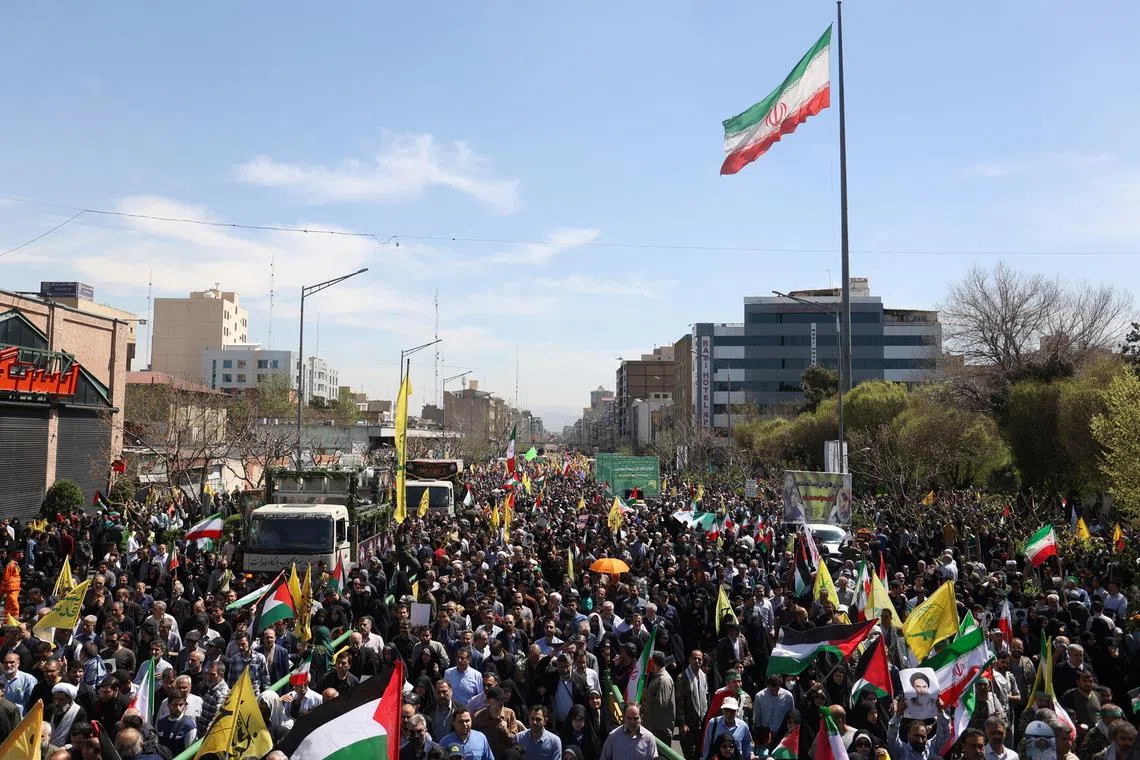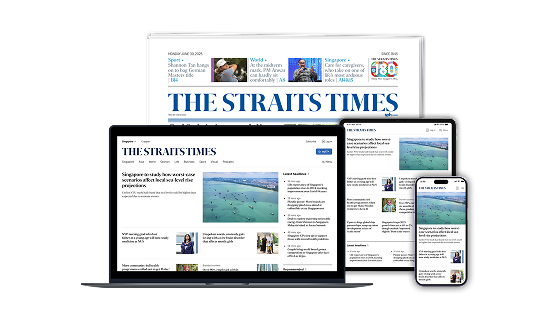A look at Iran’s military capabilities as it threatens Israel
Sign up now: Get ST's newsletters delivered to your inbox

People gathering for the funeral of members of the Islamic Revolutionary Guard Corps who were killed.
PHOTO: REUTERS
Follow topic:
NEW YORK - The possibility of a direct military confrontation between Iran and Israel has brought renewed attention to Iran’s armed forces. In April, Israel attacked a building in Iran’s diplomatic compound in the Syrian capital, Damascus, killing seven of Iran’s senior commanders and military personnel. Iran then threatened to retaliate.
Here is a look at Iran’s military and its capabilities.
Why is Iran’s military relevant right now?
After Israel attacked the Iranian diplomatic compound in Damascus,
Officials from the US and Israel assessed that Iran’s response was likely to be launched from its own territory.
That was what the Iranians did after former US president Donald Trump ordered the killing of General Qassem Soleimani in 2020, firing ballistic missiles at two US military bases in Iraq and wounding more than 100 American soldiers.
Israeli officials have said they will respond to any attack by Iran with a counter-attack, which could prompt more retaliation from Iran and possibly expand into a wider regional war. There is even a chance that a conflict of that sort could drag in the US, although Washington has made clear it had nothing to do with the Damascus attack.
While Iran is expected to mount an attack within days on Israel, US and Iranian officials said on April 12 that they did not expect the US or its military forces to be targeted.
In any case, US President Joe Biden has pledged “ironclad” support for Israel
Analysts say that Iran’s adversaries, primarily the US and Israel, have avoided direct military strikes on Iran for decades, not wishing to tangle with Iran’s complex military apparatus. Instead, Israel and Iran have been engaged in a long shadow war via air, sea, land and cyber attacks, and Israel has covertly targeted military and nuclear facilities inside Iran and killed commanders and scientists.
“There is a reason Iran has not been struck,” said Professor Afshon Ostovar, an associate professor of national security affairs at the Naval Postgraduate School and an expert on Iran’s military. “It’s not that Iran’s adversaries fear Iran. It’s that they realise any war against Iran is a very serious war.”
What sort of military threat does Iran pose?
The Iranian armed forces are among the largest in the Middle East, with at least 580,000 active-duty personnel and about 200,000 trained reserve personnel divided among the traditional army and the Revolutionary Guard, according to an annual assessment in 2023 by the International Institute for Strategic Studies.
The army and the Revolutionary Guard each have separate and active ground, air and naval forces, with the Revolutionary Guard responsible for Iran’s border security. The General Staff of the Armed Forces coordinates the branches and sets the overall strategy.
The Revolutionary Guard also operates the Quds Force, an elite unit in charge of arming, training and supporting the network of proxy militias throughout the Middle East known as the “axis of resistance”. These militias include Hezbollah in Lebanon, the Houthis in Yemen, militia groups in Syria and Iraq, and Hamas and Palestinian Islamic Jihad in Gaza.
The commander-in-chief of Iran’s armed forces is the supreme leader, Ayatollah Ali Khamenei, who has the last word on all major decisions.
While the proxy militias are not counted as part of Iran’s armed forces, analysts say they are considered an allied regional force – battle ready, heavily armed and ideologically loyal – and could come to Iran’s aid if it was attacked.
“The level of support and types of systems Iran has provided for non-state actors is really unprecedented in terms of drones, ballistic missiles and cruise missiles,” said Mr Fabian Hinz, an expert on Iran’s military at the International Institute for Strategic Studies in Berlin. “They could be viewed as part of Iran’s military capability, especially Hezbollah, which has the closest strategic relationship with Iran.”
What kinds of weapons does Iran have?
For decades, Iran’s military strategy has been anchored in deterrence, emphasising the development of precision and long-range missiles, drones and air defences. It has built a large fleet of speedboats and some small submarines that are capable of disrupting shipping traffic and global energy supplies that pass through the Persian Gulf and the Strait of Hormuz.
Iran has one of the largest arsenals of ballistic missiles and drones in the Middle East, Prof Ostovar said. That includes cruise missiles and anti-ship missiles, as well as ballistic missiles with ranges up to 2,000km. These have the capacity and range to hit any target in the Middle East, including Israel.
In recent years, Iran has assembled a large inventory of drones with ranges of around 2,000km to 2,500km and capable of flying low to evade radar, according to experts and Iranian commanders who have given public interviews to the state news media. Iran has made no secret of the build-up, displaying its trove of drones and missiles during military parades, and has ambitions to build a large export business in drones. Iran’s drones are being used by Russia in Ukraine and have surfaced in the conflict in Sudan.
The country’s bases and storage facilities are widely dispersed, buried deep underground and fortified with air defences, making them difficult to destroy with air strikes, experts say.
Where does Iran get its weapons?
International sanctions have cut Iran off from high-tech weaponry and military equipment manufactured abroad, like tanks and fighter jets.
During Iran’s eight-year war with Iraq in the 1980s, few countries were willing to sell weapons to Iran. When Ayatollah Khamenei became Iran’s supreme leader in 1989, a year after the war ended, he commissioned the Guard to develop a domestic weapons industry and poured resources into the effort, which was widely reported in Iranian news media. He wanted to assure that Iran would never again have to rely on foreign powers for its defence needs.
Today, Iran manufactures a large quantity of missiles and drones domestically and has prioritised that defence production, experts said. Its attempts to make armoured vehicles and large naval vessels have met mixed results. It also imports small submarines from North Korea while expanding and modernising its domestically produced fleet.
How do other countries see Iran’s military, and what are its weaknesses?
Iran’s military is viewed as one of the strongest in the region in terms of equipment, cohesion, experience and quality of personnel, but it lags far behind the power and sophistication of the armed forces of the US, Israel and some European countries, experts said.
Iran’s greatest weakness is its air force. Much of the country’s aircraft date from the era of Shah Mohammed Reza Pahlavi, who led Iran from 1941 to 1979, and many have been disabled for lack of spare parts. The country also bought a small fleet from Russia in the 1990s, experts said.
Iran’s tanks and armoured vehicles are old, and the country has only a few large naval vessels, experts said. Two intelligence-gathering vessels, the Saviz and Behshad, deployed on the Red Sea, have aided the Houthis in identifying Israeli-owned ships for attacks, US officials have said.
Will Israel’s attack disrupt Iran’s military?
The assassinations are expected to have a short-term impact on Iran’s regional operations, having eliminated commanders with years of experience and relationships with the heads of the allied militias. Nevertheless, the chain of command for the armed forces inside Iran remains intact, experts say, and those leaders would be the ones directing strikes on Israel or other targets and defending Iranian territory if war were to break out. NYTIMES

